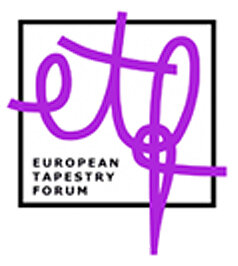ARTAPESTRY6 Exhibition Catalog
TOPICS
By Nina Hobolth, Art Historian
Visions of Nature
The view of cliffs, valleys or seascapes, an autumn field bordering the horizon, or a close-up of reflections of the sun in water: nature’s colors in tapestries -- be they sliding transitions of the finest nuances of color or sharp contrasts with black lines of contour – are recreated with deceptive force, creating fabulous scenes of rolling seaweed or life in the ocean conveyed with lyrical intensity.
Photo: Agneta B. Lind
Agneta B. Lind Lookout
Anne Marie Egemose Trails of Soils - The Harvest, Joan Baxter Hallaig 2, Ariadna Donner Lively and Silent Winter, Jane Riley In Suspension 2, Mercé Paytuvi Sequencies, Ann Naustdal The Forest Floor
Photo Realism
Weaving has many parallels with the digital world, especially with regard to its division into pixels. This is one of the reasons why so many of the exhibition’s works are derived from, and find their inspiration in, photographs: of people, of landscapes, of cities and bridges, of fire and water. The artistic translation from photo to tapestry is individual and the weaving techniques varied, but one shared element is – like photography – that the frozen moment gives the works a dimension of memories, impressions and history.
Photo: Anette Fuglsang
Lise Frølund Child
Dorthe Herup Friendship, Soile Hovila World of Contrast I-II, Jane Freear-Wyld Reflect 2, Birgitta Hallberg Sunday Morning, Lis Korsgren Morning Haze, Marianne Poulsen Road to Freedom
Picturesque Poetry
Just as photos can be brought further in an artistic processing which results in woven photo realism; picturesque, non-descriptive elements can be introduced with significant effect in tapestries in which the yarn’s glow and intensity replace the intensity and/or serenity of oils and pastels. And subsequently the element of size comes to play when the limitations of the canvas are resolved by large tapestries. Tapestry’s nature challenges the artist who will want to preserve the watercolor’s color nuances from light to dark transitions and the color of water’s “wet in wet”. Artists can also choose a clean composition of colors, forms and structures in which figurative elements can be eliminated, but where an abstract, musical influence of color and shape is achieved.
Photo: Woytek Konarzewski
Katarzyna Lavocat Trias-2
Marie-Thumette Brichard Back to the Harbour by Night 3, Fiona Hutchison Tide II, Inka Kivalo Fragrance, Thomas Cronenberg Wehmut, Mette Hansen Fragments, Joanne Soroka The Moon and Sixpence
Ornament and Symbolism
To clear the tapestry’s surface of perspective and naturalism is characteristic of this group of works. To concentrate on the surface and fill it with rhythmic repetitive patterns or symbols, for example a square or a spiral, and then to add an imbalance or the impression of a labyrinth, leads the eye to wander over the work to discover more rhythm and variation. Stringency and improvisation keep each other in check in the revelation of ancient ornaments and signs such as twists, spirals, runes, clouds, amulets and leaf shapes.
Photo: Stina Glømmi
Brita Been Chinese Cloud Jade / Skybragd Jade
Gunilla Petersson Labyrinth, Lindsey Marshall Out of Darkness, Søren Krag Untitled (Guilloché ll), Emma Nicole Straw Tapestry Collage, Wlodzimierz Cygan Organic 4 and Viruses, Anet Brusgaard Petits Gubbes d’Or de laTerre Noire, Erica Tammpere I See What I Hear
Dynamics of Space
Or you might call it the geometry of space. It’s about the components of the image breaking up the surface and making it three dimensional: it might be a simple white line woven into a black background which gives the picture depth – or a glimpse of sky composed of satellites and space waste – or a red dot that binds the geometric chaos and anchors the composition – or a cone of light over the sea: the tapestry’s “how” has gone beyond its own limitations and draws us up/out/into the universe.
Photo: Anders Elverhøy
Kristin Sæterdal Space Debris
Feliksas Jakubauskas Red Dot, Gudrun Pagter That’s It, Renata Rozsivalová Geometry of Light and Darkness, Kristin Sæterdal The Mothetship, Lívia Pápai Way to Light
Drama
Violent events and compelling emotions are displayed in a number of the exhibition’s works: from expressionistic black and white graphics to scenes of a mythological and medieval character. In one work, the tapestry grows from the wall and becomes a crucifixion sculpture. One thing they have in common is the strong voice of the teller which has us reflecting over the scene and its implications.
Photo: André Leclercq
Carmen Groza Kàra
Ann Nyberg Free Falling, Aino Kajaniemi Understanding, Zane Vizule-Jakobsena Heritage of Grandmothers, Chrissie Freeth Saint Catherine, Elmira Dementeva Satus Tempus






